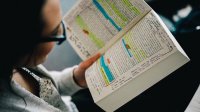6 Techniques for Building Reading Skills—in Any Subject
Students need good reading skills not just in English but in all classes. Here are some ways you can help them develop those skills.
Your content has been saved!
Go to My Saved Content.As avid lovers of literature, teachers often find themselves wanting to impart every bit of knowledge about a well-loved text to their students. And this is not just an ELA issue—other disciplines also often focus on the content of a text. However, teaching reading skills in English classes and across the disciplines is an almost guaranteed way to help students retain content. Unfortunately, the tendency to focus on the content is a real enemy to the ultimate goal of building reading skills.
Without a repertoire of reading strategies that can be applied to any text, students are being shortchanged in their education. In order to teach students to read effectively, teachers must be sure that they are not simply suppliers of information on a particular text but also instructors of techniques to build reading skills. Here are some ideas on how to incorporate reading skills lessons into a curriculum.
Teach Close Reading Skills
Guide students in annotation by directing them to do more than highlight or underline. Encourage students to have a conversation with the text by jotting notes on the text while reading—this keeps students engaged and often increases comprehension. Annotations can include:
- Defining new words
- Asking questions
- Coding recurring words and themes
- Making personal connections to the text
- Citing current events
- Highlighting heading and subheadings
- Summarizing paragraphs
- Chunking
- Categorizing information
- Numbering and ordering
- Drawing pictures
The list of possibilities is endless—the point is to have students form their own process when approaching a text. But don’t be afraid to give students specific annotation guidelines such as “annotate the writer’s characterization techniques” or “find examples of . . .” to help them focus. Annotations also help students identify which strategies work best for them as they try to process and understand information. The clip “Girls Read Comic” from The Big Bang Theory is a great way to introduce the concept of reading closely and its importance.
Appeal to the Senses
While reading is the work of the mind, incorporating the senses provides extra reinforcement for students who are still growing their skills. Reading passages aloud and verbalizing questions you would mentally ask while reading can be a great benefit to students. Students often have no idea how to ask questions, what type of questions to ask, or the frequency of questions, so modeling this skill is invaluable. This can be further reinforced especially for visual learners by using a document camera or overhead projector to write questions, mark key words and phrases, and interact with a text. And as always, encourage students to read with a pen or pencil in hand.
Guide Students in Setting Reading Goals
While writing goals are used regularly in the classroom, students do not assess personal reading skills on a regular basis. Begin the year by having students write a reader’s biography to gain insight into their reading habits, struggles, and successes; this serves as a foundation for discussions on setting reading goals. After reading a novel, nonfiction text, short story, or poetry unit, help students evaluate their reading skills: Did you feel confident reading the text? Why or why not? What parts of the text gave you trouble? Could you have used a different strategy to make reading the text easier? Students should evaluate goals on a regular basis and create new goals based on their needs and growth.
Vary Text Length
When approaching a particularly difficult text, break it up and offer it in shorter segments. Students often become discouraged with lengthy texts that require intense concentration. Giving smaller segments allows the students to digest chunks in pieces, acquire academic vocabulary, and build confidence.
Offer Opportunities for Choice Reading
Simply put, the best way to improve reading is to read, and students are more likely to read when they have a choice in the reading. Newsela and CommonLit offer a variety of nonfiction articles for choice (and CommonLit includes fiction as well); both sites include articles with various grade levels and across multiple disciplines. Classroom libraries built from donations, garage sales, and thrift shops encourage students to take books for personal reading. Ask students about their interests and make recommendations. Reading for pleasure builds transferable skills for content reading and should be encouraged, including in class.
Assess Content and Skill
Students should be able to demonstrate their skills in assessment, whether it’s formal or informal, formative or summative. Recall and comprehension questions are a good way to check for basic understanding, but teachers should then move to the harder how and why questions. Choose activities that require students to dig deep into a text, such as:
- Facilitate a socratic discussion.
- Create a playlist for a character.
- Write a formal essay.
- Make a meme for a character.
- Present a mini-TED talk on research inspired by a text.
- Create a mind map, literary 3x3, or infographic.
Most teachers already incorporate skill building in their classes to some degree; however, taking time to discuss and actively engage students in the process will keep skill development at the forefront of learning. The result will be students who not only make gains in reading but also have an understanding of how to become better readers.
